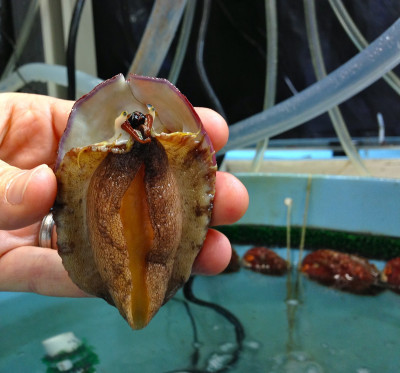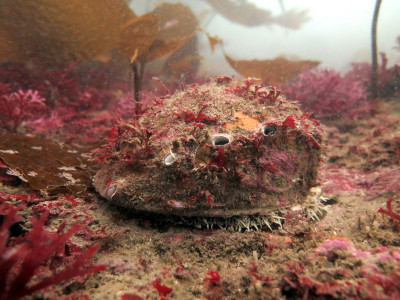In a time when the nation has faced hurricanes in the South, fires in the West, and a global pandemic, people are becoming increasingly aware of the effects of climate change. The consequences of ignoring the heavy human footprint on the world are clearer than ever. As a resident of Sonoma County, I witnessed the effects of the fires firsthand as I watched ash rain from the sky. These events not only wreak havoc on the places that we call home—they also destroy valuable parts of our ecosystem, and consequently, the diverse array of species that live within them. As humans, we exist within and influence nature, just as events within nature affect us. Furthermore, what we know about nature informs how we interact with nature, and this in turn affects the world we live in.
Regardless of how we perceive or choose to interact with nature, we can learn a valuable lesson from California’s rich history with abalone. As a graduate student interested in sustainable use of marine resources, for my internship this summer, I read about and marveled at the human coexistence with these iconic marine snails. Sustainable resource use requires extensive knowledge of marine ecosystems and the creation and nourishment of meaningful relationships between the people that use these resources. California abalone are a paradigm of what can go wrong—and what can go right—as humans work together to manage resources sustainably.


Abalone are large gastropod mollusks that inhabit the cold waters of California. While other species live elsewhere across the world, there are seven abalone species in California: white abalone, black abalone, red abalone, green abalone, pink abalone, pinto abalone, and flat abalone. These highly sought-after mollusks have been ingrained in Californian culture for centuries. The book Abalone by Ann Vileisis tells the story of the history of the seven abalone species inhabiting California coastal waters, from about 70 million years ago to 2019. Every group that was tied to abalone—including commercial and recreational fishers, tribes, and environmentalists—whether they wanted to preserve abalone for conservation purposes, cultural significance, or their livelihood - deeply cared about abalone, but struggled to develop the best path forward and the best way to address shared and sustainable use of abalone. With so many competing interests and abalone populations constantly dwindling, creating an effective management plan was a complex issue.
Environmental degradation is linked with social injustice. The diversity of user groups and types of use throughout the eighteenth century compounded with racism and xenophobia produced a disordered and ineffective management of abalone as a cultural, economic, and ecological resource. The earliest users of abalone were the Native Americans who left the earliest middens (piles of abalone shells) about 12,000 years ago. Many Native American tribes, including the Chumash, the Valley Yahi, the Hupa, the Yokuts, the Ohlone, and the Wiyot tribes valued and utilized abalone. For many of these tribes, abalone hold deep spiritual meanings, or meanings that can only be understood through ceremonies, songs, or stories that are passed down over the generations. In the late 18th century when the Spaniards began to establish settlements in California, they used abalone shells as a path to their own wealth via the Pacific fur trade. Here, the Spaniards exchanged abalone shells for otter furs, or sold them for quicksilver, which eventually became gold. This trade also decimated the populations of many indigenous peoples, who were enslaved, genocided, and killed by various diseases transferred by the Europeans. For the Chinese and Japanese immigrants to California, the abalone was already embedded in their culture and cuisine - so it is unsurprising that they propelled the California abalone fishery in the mid-late nineteenth century. But, these immigrants were eventually barred from labor due to a series of xenophobic acts, including the Chinese Exclusion Act in 1882 that prevented Chinese immigration to America and rendered them ineligible for citizenship, and the 1907 Gentlemen’s Agreement, an agreement between the U.S. and Japan that prevented Japanese laborers from entering the U.S.
For over half of the twentieth century, due to the demand for both abalone and jobs, there was frequent conflict between multiple user groups with different relationships to abalone as a resource and a way of life. For example, as abalone populations became increasingly smaller, recreational fishermen blamed commercial fishermen for depleting populations with their landings, and commercial fishermen believed the recreational fishermen were depleting abalone populations by fishing them out of shallow waters. Abalone’s popularity as a part of Californian culture peaked between the 1950s and 1970s. Although regulations for abalone diving were enforced throughout the century, the fishery was such a valuable part of the coastal economy, regulations tended to favor economic interests over conservation interests. Eventually, due to inadequate knowledge of the complexity of abalone populations and the importance of interactions between different species in marine communities, abalone were pushed to the brink of extinction. By the early 2000s, two out of seven of California’s abalone species were listed as endangered, and four out of seven have since been listed as species of concern. But, fortunately, none had yet been declared extinct.

A captive breeding program for endangered white abalone headquartered at UC Davis Bodega Marine Laboratory has produced thousands of baby white abalone that were released in the ocean for the first time in the fall of 2019, substantially increasing the size of the wild population. This effort required the coordination of universities, state and federal agencies, aquariums, aquaculture farms, former commercial and recreational fishers, and many other community members. It also required a deep understanding of the physiology and ecology of this species. Similar efforts are underway for other imperiled abalone in the state. It is the strong, inclusive partnerships and deep scientific understanding that have made these efforts so successful where earlier management and conservation efforts struggled.
In a world where nature is facing increasing pressure from growing populations and climate change, we can learn a valuable lesson from California’s history with abalone. People, whether they are immigrants, natives, fishermen, or conservationists, often care about preserving the same resources. Ensuring that these resources can be used sustainably by everyone is a complex challenge that requires cooperation and collaboration between groups, and extensive knowledge of the ecosystems that provide the services we value so much. By using these same principles, we can combat climate change and preserve species at risk today.